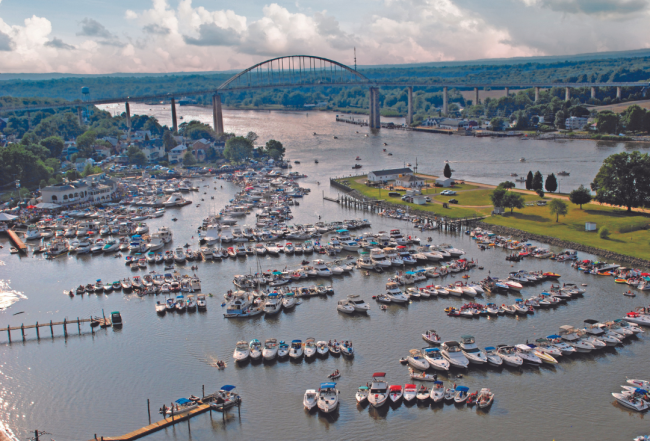
The Chesapeake & Delaware (C&D) Canal provides a safe, time-saving passage between Delaware Bay and the Chesapeake Bay. The 12-mile-long sea level cut has no locks nor tolls, inviting a great deal of commercial shipping traffic. The canal provides pleasant stretches of woods and fields, a handful of bridges in styles old and new and the opportunity to be part of the boat parade for those on the Ben Cardin C&D Canal hike-and-bike trail.
Dutch mapmaker Augustine Hermann first proposed the Chesapeake & Delaware Canal in 1661 and it won Benjamin Franklin's support in 1788. It finally opened in 1829 at a cost of 2.5 million with four locks and six-mule teams to pull towboats through. Originally the canal was 10 feet deep, 66 feet wide at the waterline and 36 feet at the channel bottom and featured several locks. Ruins of one of the original locks remain at Delaware City, DE, which lies at the eastern end of the C&D Canal.
Today the C&D Canal is administered by the Army Corps of Engineers and measures 450 feet wide with a controlling depth of 35 feet. The maximum allowable length of a self-propelled vessel transiting the canal is 886 feet. Cargo ships and military vessels from all over the world pass through the canal. Ships of this size require powerful bow thrusters to keep them on course in the C&D's close quarters and two pilots take turns on board to guide large ships through. (One is responsible for the trip from Lewes, DE, and the other takes over at Chesapeake City for the Maryland part of the journey.) Huge surges roll well ahead and astern of these behemoths even when the ships are not speeding along and the troughs left behind can send large and small boats wallowing. For the most comfortable passing maneuvers slow down and, if possible, head into wakes at an angle.
Navigating the C&D Canal
The C&D Canal is the busiest in the nation and the third busiest in the world. A whopping 40 percent of the shipping traffic in and out of the Port of Baltimore transits the C&D. Despite all the congestion daytime passage is remarkably easy. The only potential hazard, apart from ship traffic and the equipment associated with the constant dredging, is occasional debris carried in from Delaware Bay. Sometimes ice becomes a problem and the canal may adjust its operational status. If you are transiting in cold weather contact the C&D canal for updates.

"Rules of the road" for the C&D Canal include:
-
There is no speed limit on the C&D but mind right-of-way rules and use common sense. Give a wide berth to large, hard-to-maneuver watercraft. Federal regulations declare: "No vessel in the waterway shall be raced or crowded alongside another vessel. Vessels of all types, including recreational craft, are required to travel at a safe speed throughout the canal and its approaches to avoid damage by suction or wave wash to vessels, landings, riprap protection, or other boats, or injury to persons."
-
Water skiing, sailing, anchoring and jet skiing are prohibited on the C&D. Sailboats may motorsail but passage under sail alone is prohibited.
-
Transiting the canal at night is allowed (but not recommended for first timers). Stay alert in this rock-lined passage. Shore illumination, flashing canal signals and the lights of passing vessels can merge into a muddle of lights and make a night passage less than pleasant.
-
The most difficult part is sorting out the entrance markers at each end. Pay close attention to your GPS or charts and, at the Chesapeake end, carefully follow the markers through the many doglegs.
For more information on navigating the C&D Canal and other areas of the Chesapeake Bay, purchase a print Waterway Guide Chesapeake Bay Edition or a Waterway Guide Subscription.











